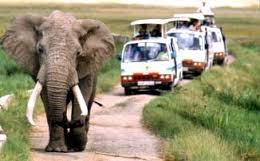Monday, January 18, 2016
Kenya is one of the world’s most popular tourism destinations
attracting millions of tourists over the past years. The country is
endowed with attractive tourist sites, rich culture, striking
geographical diversity and landscapes ranging from beautiful beaches, to
animal parks and archeological sites.
The tourist destinations are well distributed all over the country.
Currently, Kenya has six properties inscribed on the World Heritage
List. These include cultural properties which are: Fort Jesus Mombasa,
Lamu Old Town, Sacred Mijikenda Kaya Forest and Natural Properties which
are Kenya Lake System in the Great Rift Valley, Lake Turkana National Parks and Mount Kenya Natural Forest.
Fort Jesus Mombasa
The Fort Jesus is one of the most outstanding historical sites and preservations of the 16th century. It was built and designed of Giovanni Battista Cairati with the aim of protecting the port of Mombasa from external invasion. The fort occupies an area of 2.36 hectares.
Lamu Old Town
Lamu Old Town is an exclusive tropical island and one of the oldest best preserved Swahili settlements in East Africa. It is one major center for the study of Islam and Swahili cultures with many elite visiting for educational purposes. It is built in coral stone and mangrove timber. Lamu is also characterized by the simplicity of many structural forms enriched by ideal features such as elaborately carved wooden doors, verandas, and inner courtyards.
Sacred Mijikenda Kaya Forest
The Mijikenda Kaya sacred forests consist of 11 separate forest sites. It is yet another 16th century phenomenon with remains of several fortified villages locally known as Kayas. The land occupies 200km and is famed for bearing a living cultural tradition.
Natural Properties
The Kenya Lake SystemThe Kenya Lake System is located in the Great Rift Valley. It is an outstanding natural beauty consisting of relatively shallow lakes which are, Lake Bogoria, Lake Nakuru, and Lake Elementaita. The region is a home for sizeable animals such as the Black rhinos, Rothschild giraffes, lions and cheetahs. It is also a habitat to 13 globally threatened bird species and the single most important foraging site for the lesser flamingo. The area covers a total of 32, 034 hectares.
Lake Turkana National Parks
The Lake Turkana is a serene tourist site serving as a study centre for plant and animal communities and a rich animal habitat. It is a stopover for the migrant Waterfowl and a breeding area for the Nile crocodile, hippopotamus as well as various venomous snakes. The Lake is the most saline of all Africa’s big lakes. Many educationists visit the Koobi Fora deposits, an archeological site, which is rich in mammalian and fossil remains. The site has contributed a lot to the understanding of paleontology than any other site on the continent.
Mount Kenya Natural Forest
Mount Kenya is an extinct volcano with a very impressive landscape with four secondary peaks and 12 remnant glaciers. The four secondary peaks sit at the head of the u-shaped glacial valleys. It is the second highest mountain in Africa, 5, 199m and has forested middle slops.
The Government is working towards fulfilling the 2012 vision of receiving 2 million tourists in Kenya annually. Kenya has experienced a 15% tourist growth since 2009. The country recorded a total of 1,095,945 tourist arrivals in 2010, hitting the highest figure ever. The numbers have since went up during the first six months of 2011, from 549, 083 compared to 483,468 in the same period in 2010. These figures exclude cross border tourist arrivals which total to 700,000.
Contrary to the past years when Kenyans perceived tourism and holidays as an International affair, local tourism has increased considerably over the years. This has also contributed to the increase of tourism revenues and the impressive performance as well as aggressive marketing in non-traditional markets and efficient utilization of available resources.
The tremendous growth is posing new opportunities for new investors and for businesses already in the tourism industry that are willing to step up their services to meet current international needs. Kenya Tourist Development Corporation is mandated to develop and diversify the Kenya’s Tourism industry by financing and offering advisory services to new investors and businesses in the tourism industry.






0 comments:
Post a Comment